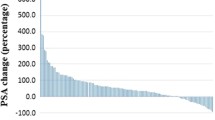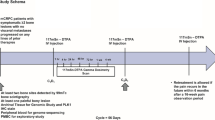Abstract
Objective
Strontium-89 (Sr-89) has been considered to have a tumoricidal effect with minimal adverse events. However, few reports have investigated these effects in detail. In this study, we examined the tumoricidal and pain-relief effects of Sr-89 on prostate cancer with bone metastasis as well as survival.
Methods
A retrospective study was performed involving 31 prostate cancer patients with bone metastasis treated with Sr-89. Using PSA as an evaluation criterion of cancer control, patients were divided into PSA responder and non-responder groups, and the survival rates of these groups were compared. In addition, using the total amount of painkillers administered as an evaluation criterion of pain relief, patients were divided into pain responder and non-responder groups, and the survival rates of these groups were also compared. As secondary investigation items, age, PSA (ng/ml), pain site, extent of the disease, the presence or absence of castration-resistant prostatic cancer (CRPC), the presence or absence of a past medical history of treatment with docetaxel in CRPC cases, Gleason Score, hemoglobin (g/dl), platelet (Plt) (/μl), serum carboxyterminal telopeptide of type I collagen (ng/ml), and bone-alkaline phosphatase (BAP) (U/l) were investigated.
Results
Longer survival was expected for the PSA responder group than for the PSA non-responder group, and whether the spine was the pain site and the presence or absence of CRPC were useful as predictors of this. Plt was suggested to be a useful indicator. Furthermore, the survival time was significantly longer in the pain responder group than in the pain non-responder group, and whether the pain site was present in the spine was considered to be a predictor; however, no significant difference was noted in any of the items assumed to be biomarkers.
Conclusions
Sr-89 has the potential to control PSA and prolong survival. A large-scale prospective study of the therapeutic effect of Sr-89 is expected.


Similar content being viewed by others
References
Jemal A, Bray F, Center MM, Ferlay J, Ward E, Forman D. Global cancer statistics. CA Cancer J Clin. 2011;61:69–90.
Namiki M, Akaza H, Lee SE, Song JM, Umbas R, Zhou L, et al. Prostate Cancer Working Group report. Jpn J Clin Oncol. 2010;40(Suppl 1):i70–5.
Nakata S, Ohtake N, Yamanaka H. Epidemiology of prostate cancer in Japan. Nihon Rinsyo. 2011;69(Suppl 5):181–6 (in Japanese).
Armstrong AJ, Tannock IF, de Wit R, George DJ, Eisenberger M, Halabi S. The development of risk groups in men with metastatic castration-resistant prostate cancer based on risk factors for PSA decline and survival. Eur J Cancer. 2010;46:517–25.
Blake GM, Zivanovic MA, Blaquiere RM, Fine DR, McEwan AJ, Ackery DM. Strontium-89 therapy: measurement of absorbed dose to skeletal metastases. J Nucl Med. 1988;29:549–57.
Zyskowski A, Lamb D, Morum P, Hamilton D, Johnson C. Strontium-89 treatment for prostate cancer bone metastases: does a prostate-specific antigen response predict for improved survival? Australas Radiol. 2001;45:39–42.
Armstrong AJ, Tannock IF, de Wit R, George DJ, Eisenberger M, Halabi S. The development of risk groups in men with metastatic castration-resistant prostate cancer based on risk factors for PSA decline and survival. Eur J Cancer. 2010;46:517–25.
de Bono JS, Oudard S, Ozguroglu M, Hansen S, Machiels JP, Kocak I, et al. Prednisone plus cabazitaxel or mitoxantrone for metastatic castration-resistant prostate cancer progressing after docetaxel treatment: a randomised open-label trial. Lancet. 2010;376:1147–54.
Scher HI, Fizazi K, Saad F, Taplin ME, Sternberg CN, Miller K, et al. Increased survival with enzalutamide in prostate cancer after chemotherapy. N Engl J Med. 2012;367:1187–97.
Porter AT, McEwan AJ, Powe JE, Reid R, McGowan DG, Lukka H, et al. Results of a randomized phase-III trial to evaluate the efficacy of strontium-89 adjuvant to local field external beam irradiation in the management of endocrine resistant metastatic prostate cancer. Int J Radiat Oncol Biol Phys. 1993;25:805–13.
Turner SL, Gruenewald S, Spry N, Gebski V, Metastron Users Group. Less pain does equal better quality of life following strontium-89 therapy for metastatic prostate cancer. Br J Cancer. 2001;84:297–302.
Yoshimura M, Saito K, Park J, Akata S, Koizumi K, Tokuue K, et al. Tumoricidal effect of strontium-89. Clin Nucl Med. 2011;36:296–9.
Tu SM, Lin SH, Podoloff DA, Logothetis CJ. Multimodality therapy: bone-targeted radioisotope therapy of prostate cancer. Clin Adv Hematol Oncol. 2010;8:341–51.
Vengalil S, O’Sullivan JM, Parker CC. Use of radionuclides in metastatic prostate cancer: pain relief and beyond. Curr Opin Support Palliat Care. 2012;6:310–5.
Conflict of interest
None.
Author information
Authors and Affiliations
Corresponding author
Rights and permissions
About this article
Cite this article
Kuroda, I. Strontium-89 for prostate cancer with bone metastases: the potential of cancer control and improvement of overall survival. Ann Nucl Med 28, 11–16 (2014). https://doi.org/10.1007/s12149-013-0775-8
Received:
Accepted:
Published:
Issue Date:
DOI: https://doi.org/10.1007/s12149-013-0775-8




